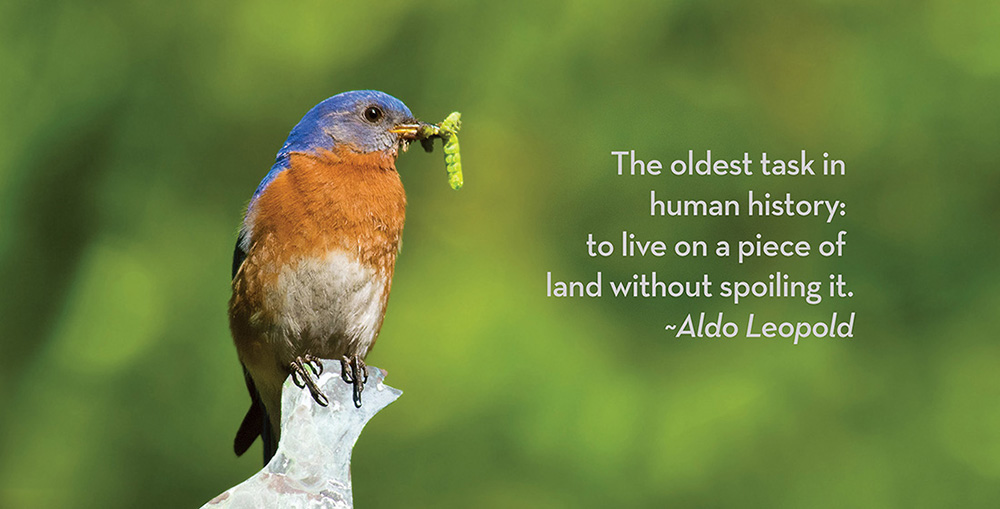The Importance of Native Plants

By now, many of us have heard the term ‘native’ plants. But what actually are native plants? And what’s the big deal about them? Native plants are, in one word, local. They have been growing in a particular area for thousands of years. They are well adapted to the conditions of their ecosystem, as they have evolved slowly over time.
Why is the concept of native vs. non-native plants so important? Douglas Tallamy’s book, Nature’s Best Hope – A New Approach to Conservation That Starts in Your Yard, explains how wildlife is impacted not only by loss of habitat, but also by the displacement of native flora with non-native and invasive species. This is important because native insects and birds are not nourished by non-native plants. Turf grass, for example, and forsythia, Japanese barberry, burning bush, hostas, baby’s breath, all these common plants are useless from an ecological standpoint. With insects and pollinators having very little food available, and birds consequently in decline, we currently face a situation with cascading and dire consequences.
According to Tallamy, wildlife has been in a state of decline for decades, but we are now in a critical period. In spite of the national park system, national forests, wilderness areas, efforts by environmental organizations like Sierra Club and Nature Conservancy, and land conservancies nationwide, species continue to dwindle, become critically endangered, and disappear altogether.
The plight of the monarch butterfly is a sad example. The decimation of the monarch’s habitat, including milkweeds where monarchs feed and breed, and asters and goldenrods that sustain them during fall migration, has reduced their numbers by more than 90%. Other species like the pipevine swallowtail butterfly, the rusty-patched bumble bee, Newman’s brocade moth, and dozens more in Michigan are threatened or endangered. The American burying beetle is already extinct in Michigan.
Although the monarch butterfly is the poster child of species decline, specialized relationships among plants and animals are the rule rather than the exception in nature. Insects sustain the earth’s ecosystems by sustaining the plants and animals of those ecosystems. The benefits that insects convey are too numerous to list, but among them are the plants that insects pollinate sequester enormous amounts of carbon, and pollinating insects support 70% of the food we eat. We literally could not exist without insects! The good news is that there is a solution to this vexing and life-changing problem facing us today.
Tallamy’s research shows that more than 83% of the U.S. is privately owned. If conservation is to happen, it can and must happen largely on private property, but not just on farms and ranches. It must include all types of private property, from the smallest city lot to the largest corporate landscape. Public preserves are not enough to sustain biodiversity into the future.
A great resource lies right under our noses that we can focus on now to immediately begin reversing the precipitous decline of species. That resource is right in our yards. Literally, Tallamy explains, our back yards (and front yards too) offer millions of square acres that can be transformed into pockets of conservation that provide wildlife habitat. He proposed calling this effort: Homegrown National Park (HNP)
Invite monarchs and other pollinators back into your yard by giving up some lawn and planting milkweed and other beautiful native wildflowers and shrubs. Plant some oak trees, a keystone species that has a disproportionately beneficial effect compared to other native plants. Plant a White Snowberry, Spicebush, or Chokecherry, which will provide nutritious berries to native birds. As the author states, building HPN will be the most ambitious restoration initiative ever undertaken. Instead of being careless with our environment, we can recognize the vital importance of adding nature back in to our surroundings. HNP does not discriminate and has no political, ideological, or religious boundaries, because we all need diverse, productive ecosystems to survive. We have the intelligence and knowledge to restore our habitat. Now we just have to do it!
Actions you can take right now to help reverse species decline
Shrink your lawn. You don’t have to get rid of it entirely but you can build beds, or pocket prairies, full of native wildflowers and plants.
Remove invasive species – Invasive plants displace native plants and offer zero nourishment to local wildlife. (e.g. Myrtle, English Ivy, Dame’s Rocket*)
Plant keystone plants – Keystone plants are native plant superstars. They provide the highest level of resources for the species that support the food web. (Oak, Maple, Cottonwood, & many more*)
Be generous with plantings – Instead of just planting 1 tree, plant 3 or more. You want to mimic what would occur naturally. Include understory trees and shrubs to the landscape.
Work with your neighbors – Look for like-minded neighbors to join in the endeavor.
Help caterpillars – Birds prefer caterpillars for feeding their young. Create caterpillar pupation sites under trees. Most caterpillars drop to the ground and pupate there. Replace lawn under trees with beds full of ground cover. Don’t clean up leaves under trees in the fall.
Don’t spray or fertilize – Native plants are adapted to low nitrogen soils and don’t need fertilizer.
Get on the HOMEGROWN NATIONAL PARK map – Join the national movement and register your yard.
Northwest Michigan Native Plant Resources:
- Homegrown National Park
- Laurel Voran specializes in native plants and installation
- Eran Rhodzell, landscaper specializing in native edible and medicinal plants
Sacred Earth Landsaping - Four Season Nursery in Traverse City offers consulting services for native gardens
- Carolyn Thayer, Designs in Bloom, Frankfurt, Michigan
- Gobeyondbeauty.org
- Learn more about invasive species habitatmatters.org
- Great general resource Plantitwild.net
- Local native plant nursery birdsfootnativenursery.com
- Local native plant nursery blackcapplants.com
- Great online native plants prairienursery.com
- Another online source directnativeplants.com
- Wildflowersmich.org
- Grants for native plants for farms, ranches, landowners available from the USDA